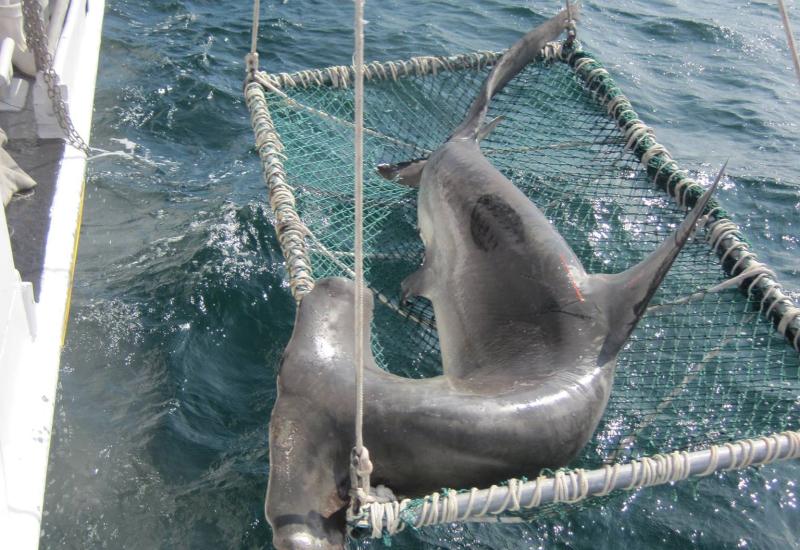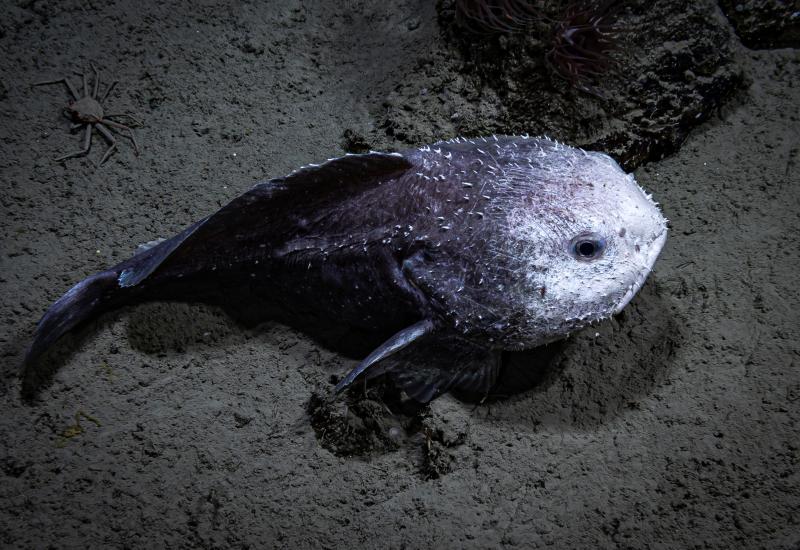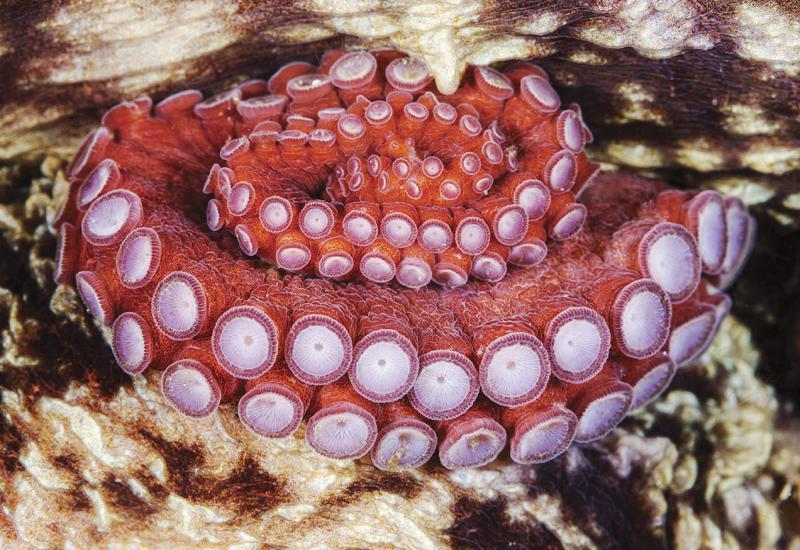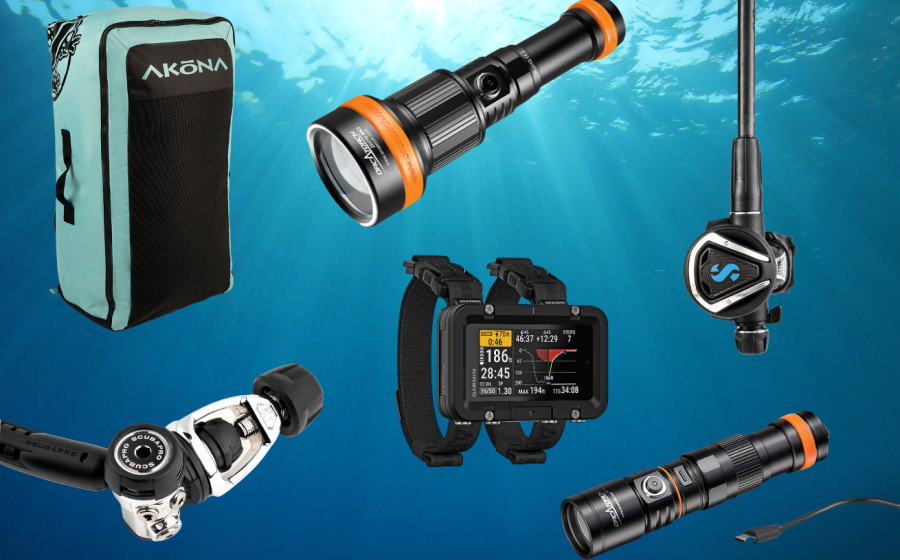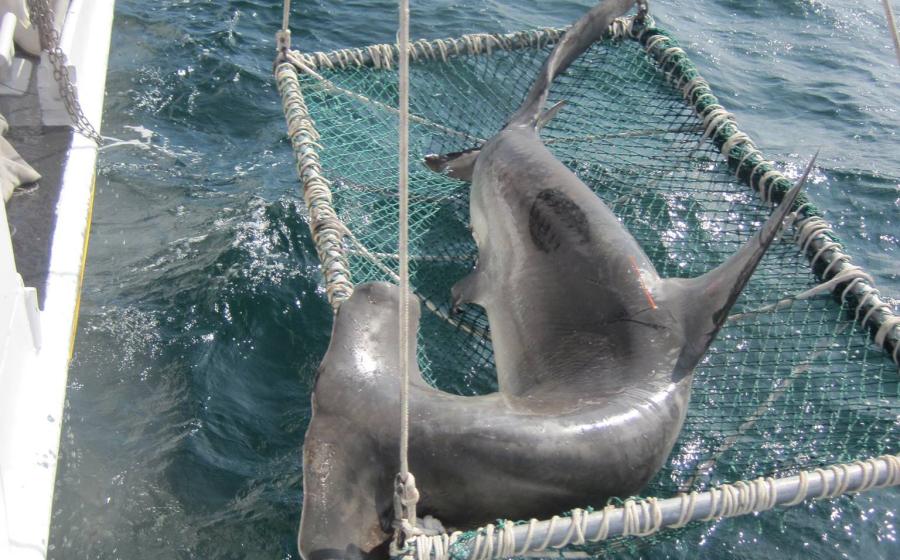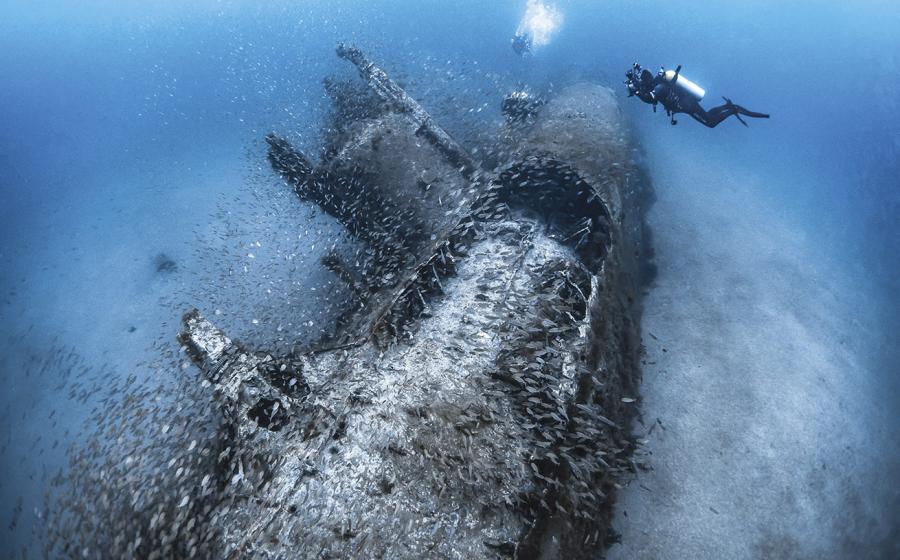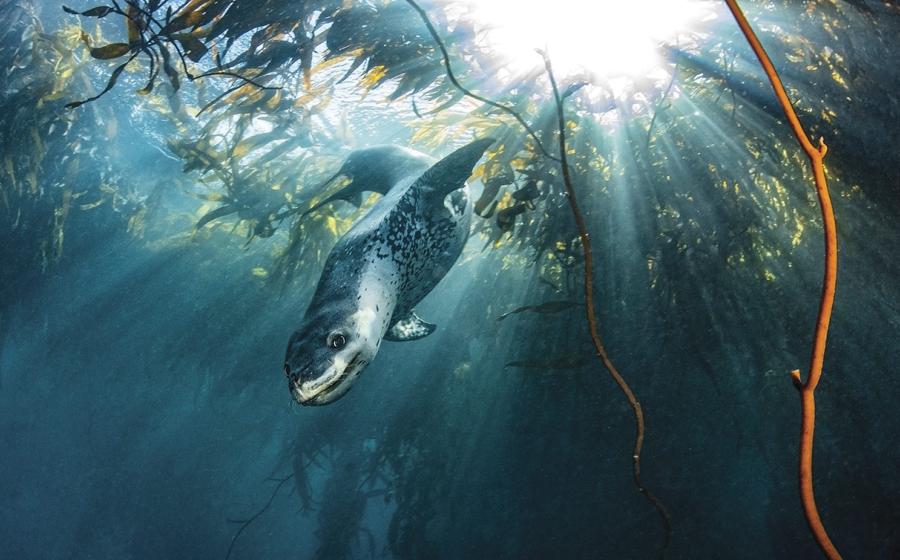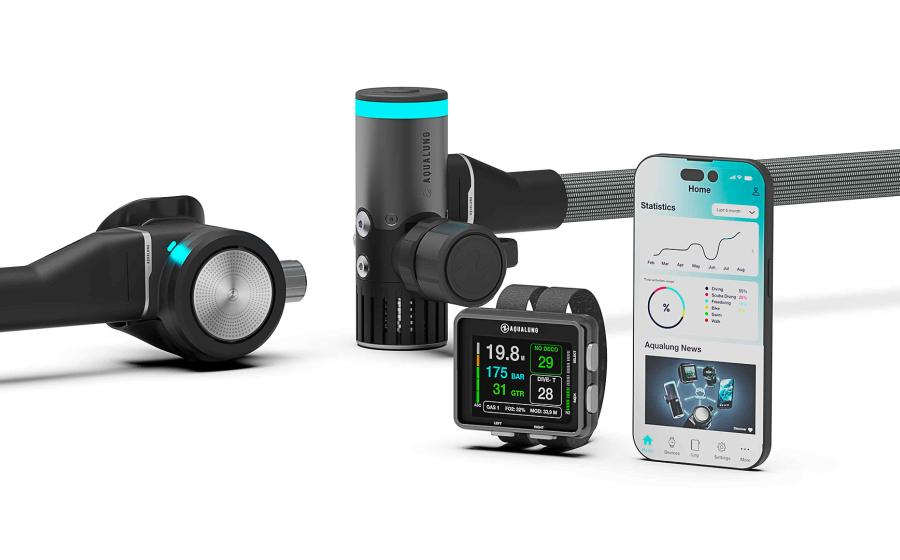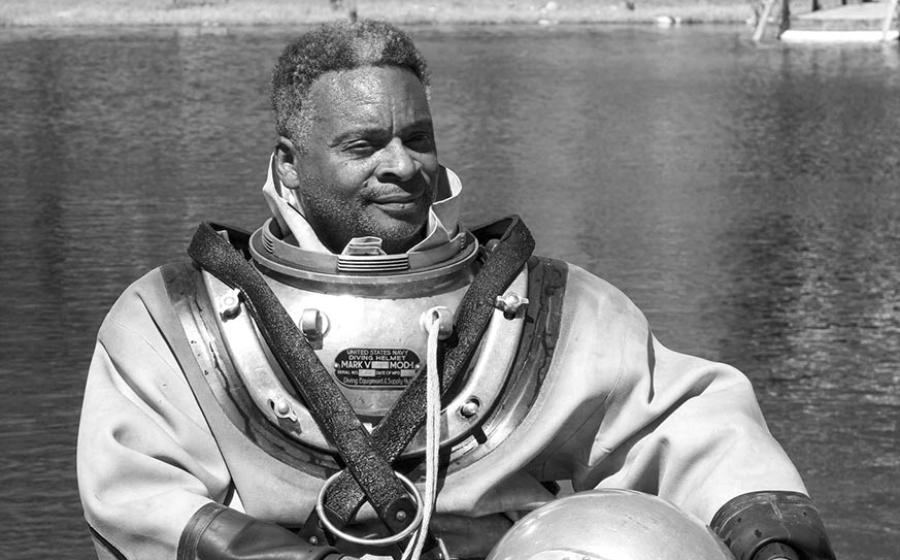Diving Bali's USAT Liberty Wreck [Photo Gallery]
The USAT Liberty was a transport ship (not a Liberty ship as many mistakenly believe — Liberty ships were not built until World War II). It was built as a merchant ship in New Jersey, USA, launched in 1918, and was shortly thereafter commissioned by the U.S. Navy to serve in World War I.
Between the world wars, the Liberty went back to merchant services in the Atlantic. At the beginning of World War II, it was again commissioned, this time by the U.S. Army as a supply ship, and it was relocated to Asia.
In 1942, the Liberty, carrying parts related to the war effort from Australia to the Philippines, was torpedoed by a Japanese submarine, off the coast of Bali. The badly damaged ship was towed toward dry dock with the hope of saving it, but it could not make it that far, and so it was unloaded and then beached at Tulamben, on the northeastern coast of Bali, where it sat and rusted for many years. Fast forward to 1963 when Gunung Agung volcano (which towers over the region) blew its top; the force of the eruption was so intense that it dislodged the ship and pushed it off the beach and out onto the sloping reef just offshore.
At just over 400 feet long, with a 55 foot beam, the Liberty was quite a big vessel. For the most part, the wreck, which lies on its side, is intact, although some bits have broken off and embedded themselves in the sandy slope on which the ship rests. Although the anchor was salvaged at some point, there are still recognizable guns on the boat. The ship’s structure, being metal, is slowly disintegrating and collapsing upon itself, but it is still possible to safely swim into some of the large cargo holds, although probably not for much longer. The highest point on the ship (in the bow area) is not more than 20 feet in depth. Off the deep end of the ship (the downhill side) the maximum depth is about 90 feet. As such, this is a good dive for Nitrox.
I have dived the Liberty well over a half dozen times and I’ve enjoyed every visit. I will confess that I am not a super keen wreck diver — I tend to look at wrecks, not so much with historical or archeological interest, but more for the impressive artificial reef/ecosystem that they have become.
From Scuba Seraya Dive Resort, where I have had the pleasure to stay and dive with on several occasions, the wreck is a short boat ride away. The Liberty is also a relatively easy access shore dive from the public beach at Tulamben — just a quick swim out. As such, numerous dive operators from all over Bali bring busloads of divers for tours of the wreck daily. Several other Tulamben area dive resorts also provide a steady stream of traffic, and so it can be a busy site. Also of note is that parts of the Liberty are in such shallow water that it makes it a good destination for snorkelers. So, for the most serene, least crowded, most probable opportunities to see the larger animals that make their home on the wreck, it is recommended to plan to dive it early in the morning or late in the afternoon. The Liberty is also an awesome night dive, except when subjected to tidal currents.
For DSLR photographers, I would recommend trying to plan to dive the Liberty a minimum of three times. For the first dive, I would suggest touring the entire ship with your camera set up for wide-angle, and bag yourself some nice, sculptural shots. You can circumnavigate the whole wreck on one dive, if you are good on gas. If you are lucky, and the visibility gods are with you, the big ball of jacks that sometimes orbits the wreck will be visible and fun to try to photograph.
Then, for the second dive, I’d suggest screwing on a mid-range lens for fish portraits. You will have already scouted and found numerous fixed or non-migratory subjects to shoot on this dive, including several varieties of anemonefish — both on the wreck (look for the red tomato anemone on the tilted deck, near the bow, at about 45 feet), and spine-cheek anemonefish in the sandy shallows immediately adjacent to the wreck. Look for the big barracuda that lurks in the holds. There are massive resident groupers, and a school of bumphead parrotfish that tend to leave the wreck quite early in the morning, and return to it in the evening to wrap themselves up in their mucus "sleeping bags" for the night. There are sweetlips, filefish, triggerfish, parrotfish, lionfish, garden eels (in 25 feet of water!), sergeant majors galore, and so much more on this fantastic site.
For your third dive, get ready for macro. There is at least one pygmy seahorse on the Liberty. If you are fortunate enough to get to see it/them, please refrain from taking scores of pictures — the little guys are light sensitive and it clearly disturbs them to be strobed. Also, they typically make their homes on very fragile sea fans, so great care must be taken not to contact them when coming in for a close-up. A good guide will use his or her pointer to show you where the pygmy is (hopefully not touching the fan) — the ones I squinted at (and then pointed my camera and prayed) were no larger than a grain of rice. There are also a couple of leaf scorpionfish on the wreck, numerous nudibranchs, soft coral crabs, shrimp gobies in the sand, crinoid squat lobsters, ornate ghost pipefish and porcelain crabs, and so much more.
Not to be overlooked are the coral patches on the sand around the wreck — this is where we saw ornate ghost pipefish, numerous nudibranchs, several varieties of eels, a bubble anemone with resident spine-cheek anemonefish, and there is a cool cleaning station about 30 yards from the wreck, on a small bommie, where the cleaner shrimp will clean your nails, and even your teeth, if you are so inclined. Also, not far from the wreck are several areas of sloping “muck,” which, although lacking any significant reef structure, are great for macro critter sightings. In fact, in addition to the star attraction of the Liberty wreck, there is quite a lot of fantastic muck diving in the Tulamben area, as well as pretty reefs.
Finally, Bali itself is a beautiful, fascinating destination, with ample tourism infrastructure for all budgets. Beaches, resort towns, surfing, Ubud (the artists’ town), water gardens, hiking – there are many options for diversions when not diving. International nonstop flights to Bali are available through several hubs, including Jakarta, Singapore, Bangkok, Sydney, and others. Bali is also the gateway to many other prime dive areas in Indonesia – Komodo, Banda Sea, Raja Ampat, to name a few. I’ve always found it to be a great trip to plan a few days of diving in Tulamben before heading out on a live-aboard adventure in one of these areas, but diving the Tulamben area of Bali is truly worthy of a trip of its own.
Judy is an avid underwater photographer and traveler whose work has appeared in several dive publications. Judy also shares a comprehensive dive travel and photo blog.
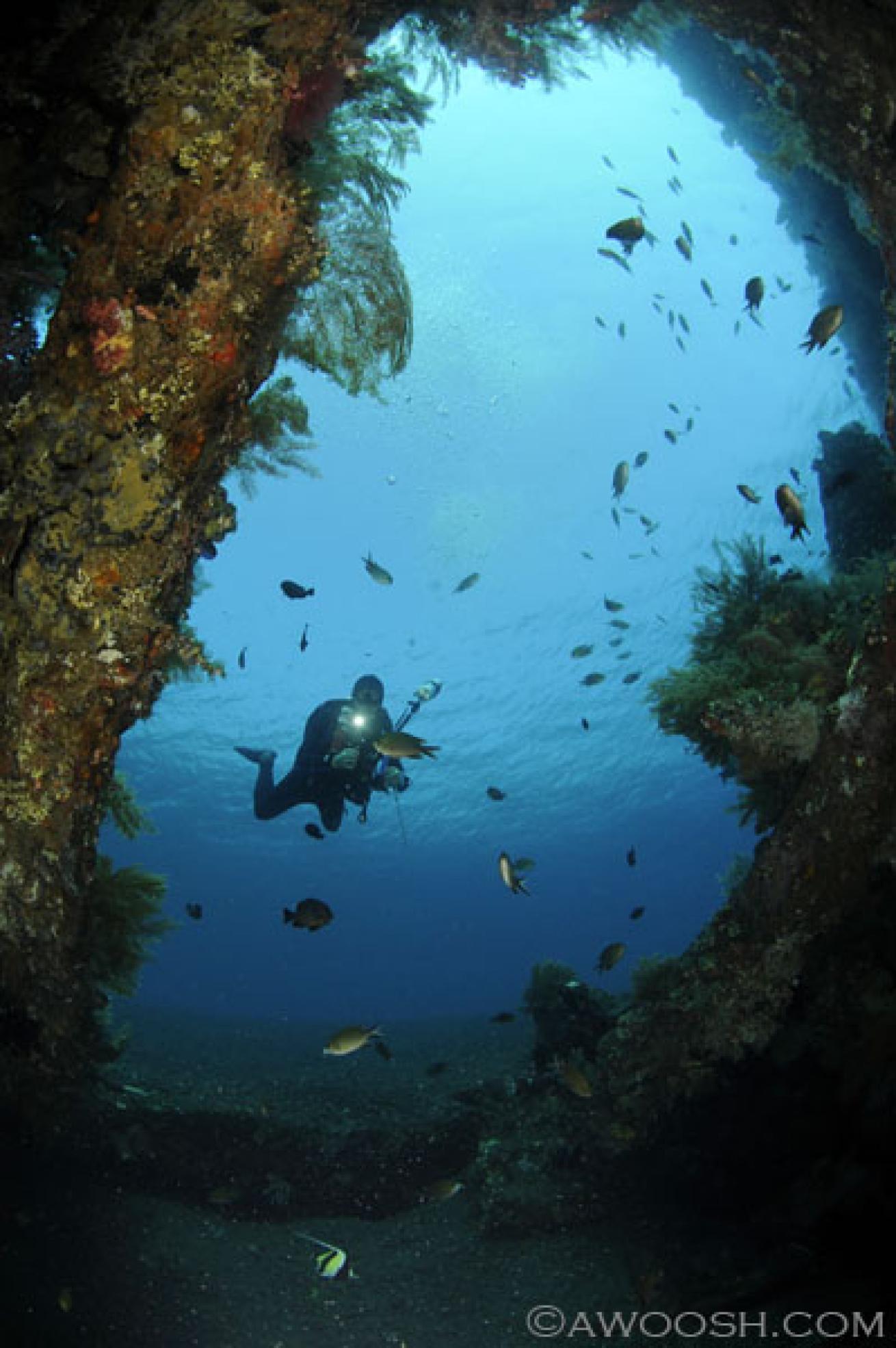
Judy GThis is a view of the stern of the wreck. At one time the ship’s large propeller would have been located here, but it was salvaged so no longer viewable on the site.
The USAT Liberty was a transport ship (not a Liberty ship as many mistakenly believe — Liberty ships were not built until World War II). It was built as a merchant ship in New Jersey, USA, launched in 1918, and was shortly thereafter commissioned by the U.S. Navy to serve in World War I.
Between the world wars, the Liberty went back to merchant services in the Atlantic. At the beginning of World War II, it was again commissioned, this time by the U.S. Army as a supply ship, and it was relocated to Asia.
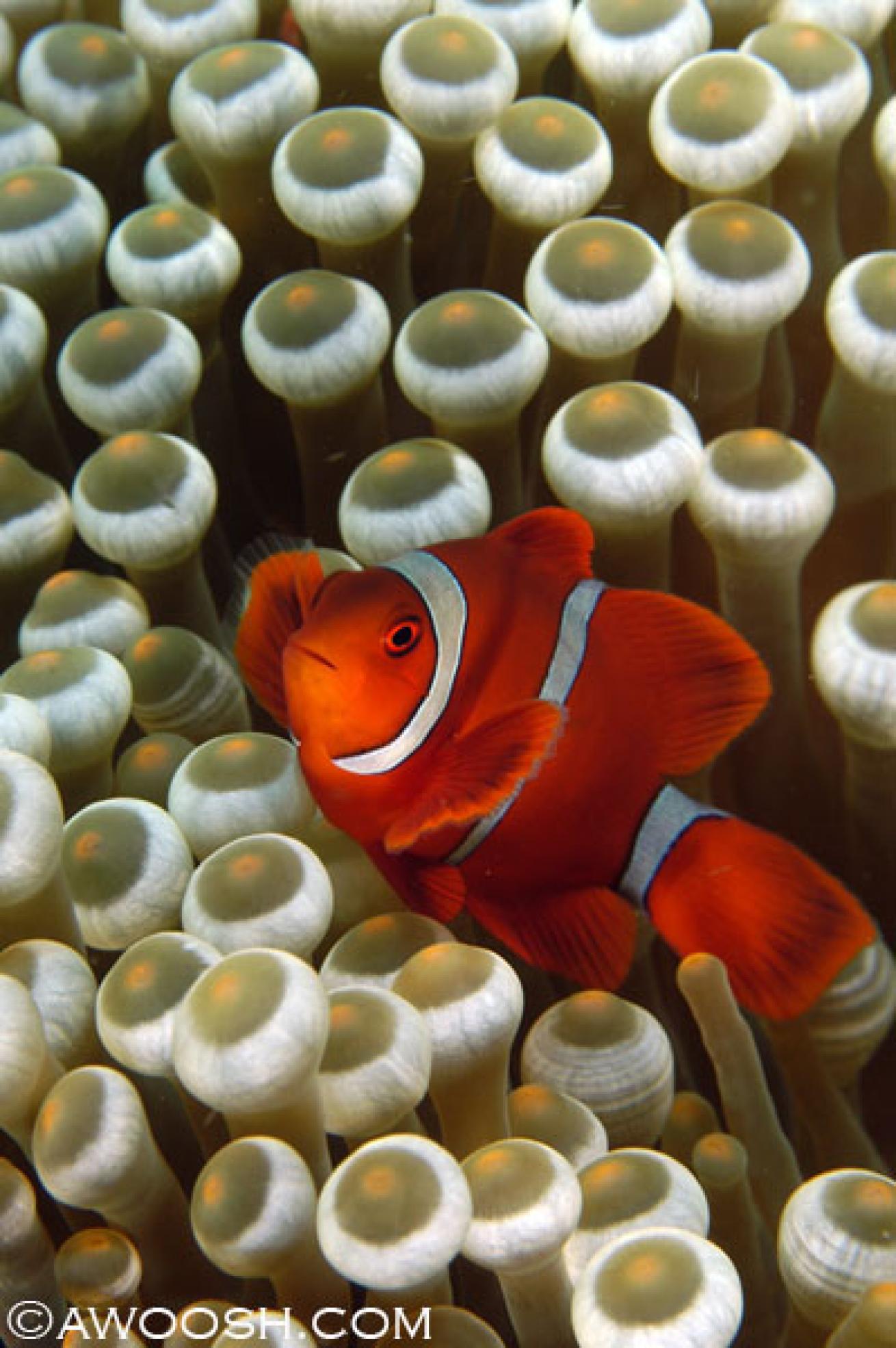
Judy GSpinecheek Anemonefish (Premnas biaculeatus) – male – on a bubble anemone. These beautiful fish are usually found in pairs. The smaller and more vibrantly colored of the pair is the male. This one was about 3 inches long. Of all the varieties of anemone fish I’ve seen and photographed, these are the slowest moving.
In 1942, the Liberty, carrying parts related to the war effort from Australia to the Philippines, was torpedoed by a Japanese submarine, off the coast of Bali. The badly damaged ship was towed toward dry dock with the hope of saving it, but it could not make it that far, and so it was unloaded and then beached at Tulamben, on the northeastern coast of Bali, where it sat and rusted for many years. Fast forward to 1963 when Gunung Agung volcano (which towers over the region) blew its top; the force of the eruption was so intense that it dislodged the ship and pushed it off the beach and out onto the sloping reef just offshore.
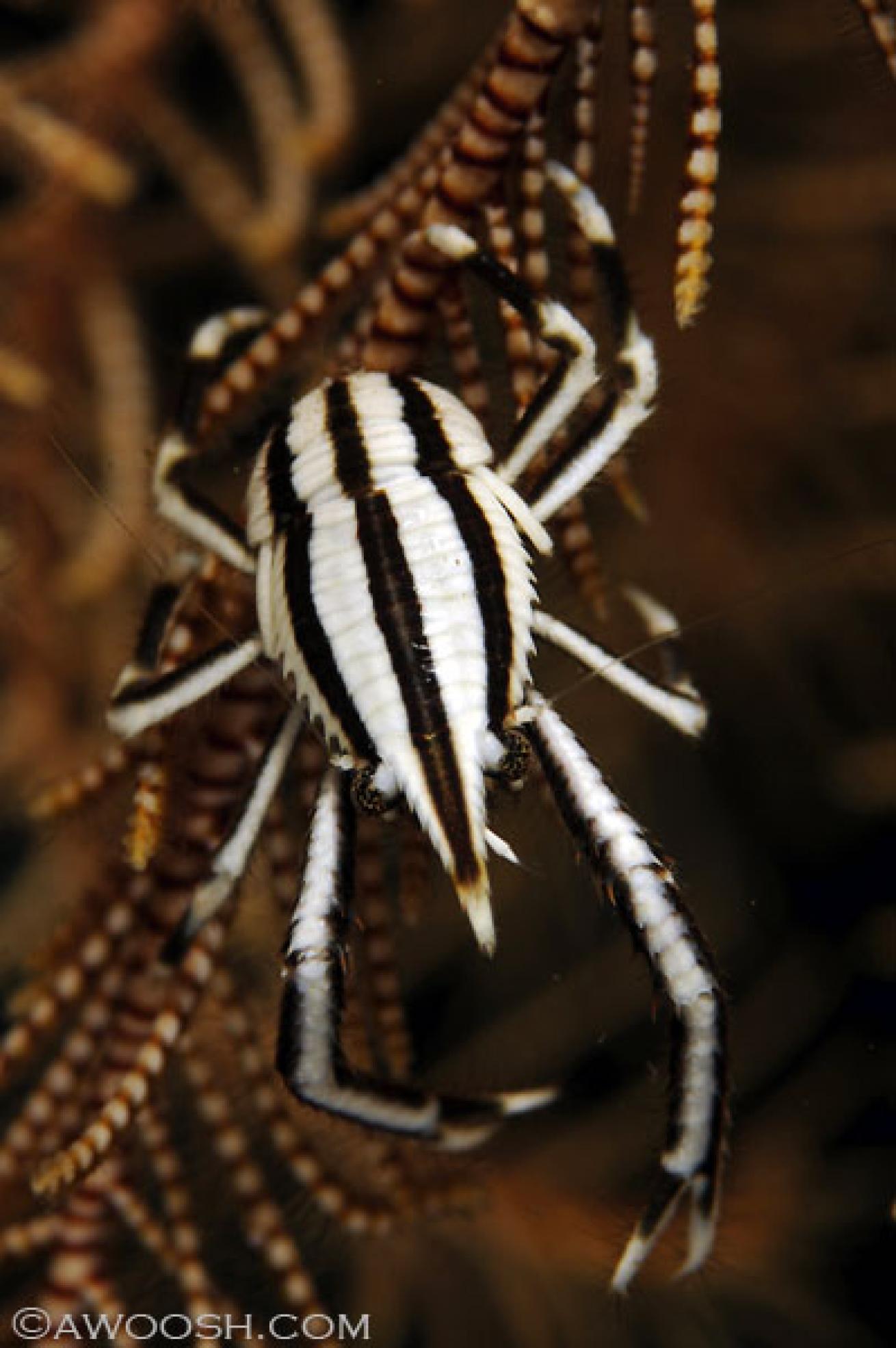
Judy GElegant Crinoid Squat Lobster (Allogalathea elegans), found on a night dive on the wreck. In current, at night, this truly was a lucky capture.
At just over 400 feet long, with a 55 foot beam, the Liberty was quite a big vessel. For the most part, the wreck, which lies on its side, is intact, although some bits have broken off and embedded themselves in the sandy slope on which the ship rests. Although the anchor was salvaged at some point, there are still recognizable guns on the boat. The ship’s structure, being metal, is slowly disintegrating and collapsing upon itself, but it is still possible to safely swim into some of the large cargo holds, although probably not for much longer. The highest point on the ship (in the bow area) is not more than 20 feet in depth. Off the deep end of the ship (the downhill side) the maximum depth is about 90 feet. As such, this is a good dive for Nitrox.
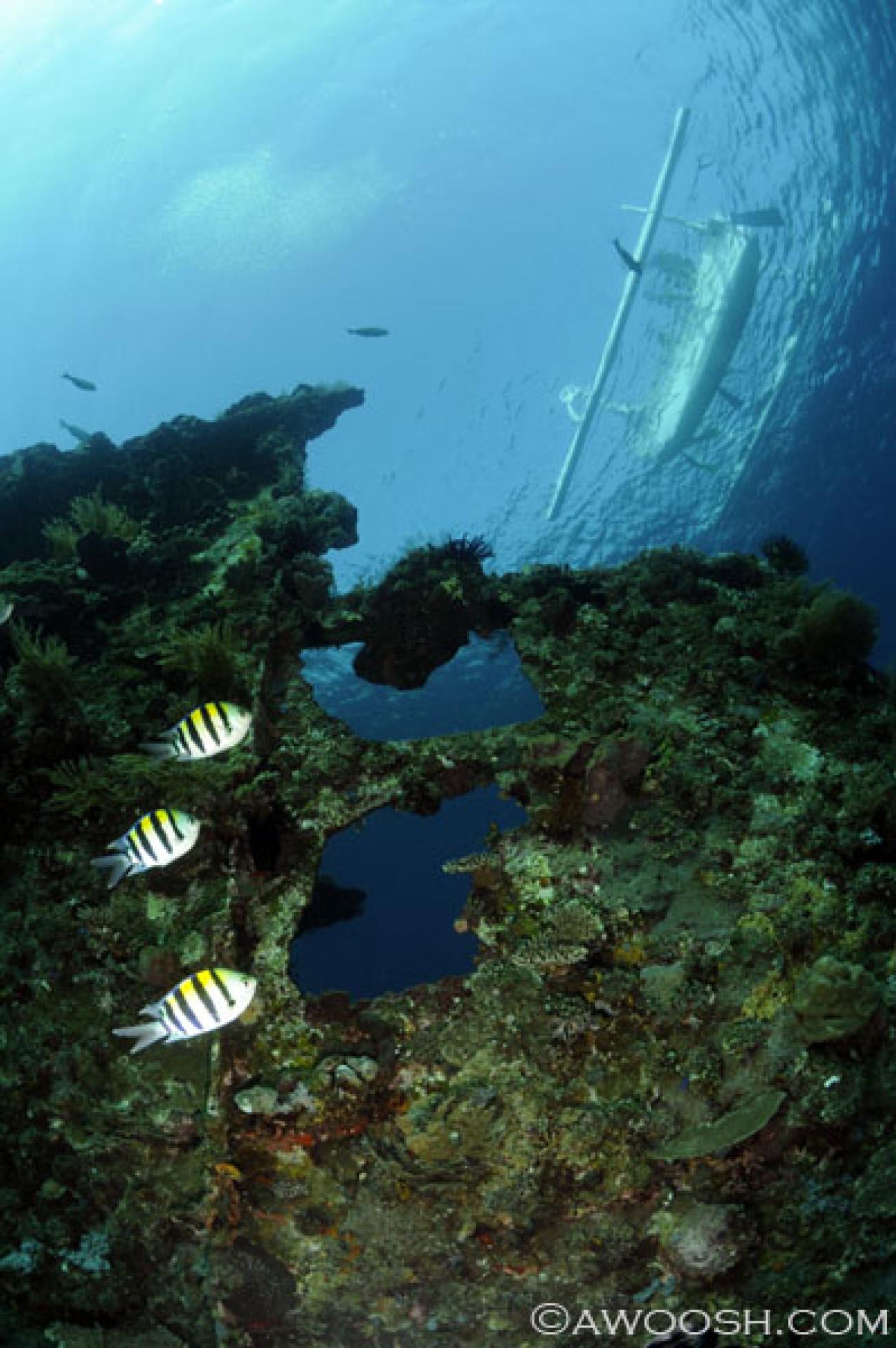
Judy GThis was taken around mid-ships of the wreck. The boat at the surface with outriggers is a typical local Indonesian craft.
I have dived the Liberty well over a half dozen times and I’ve enjoyed every visit. I will confess that I am not a super keen wreck diver — I tend to look at wrecks, not so much with historical or archeological interest, but more for the impressive artificial reef/ecosystem that they have become.
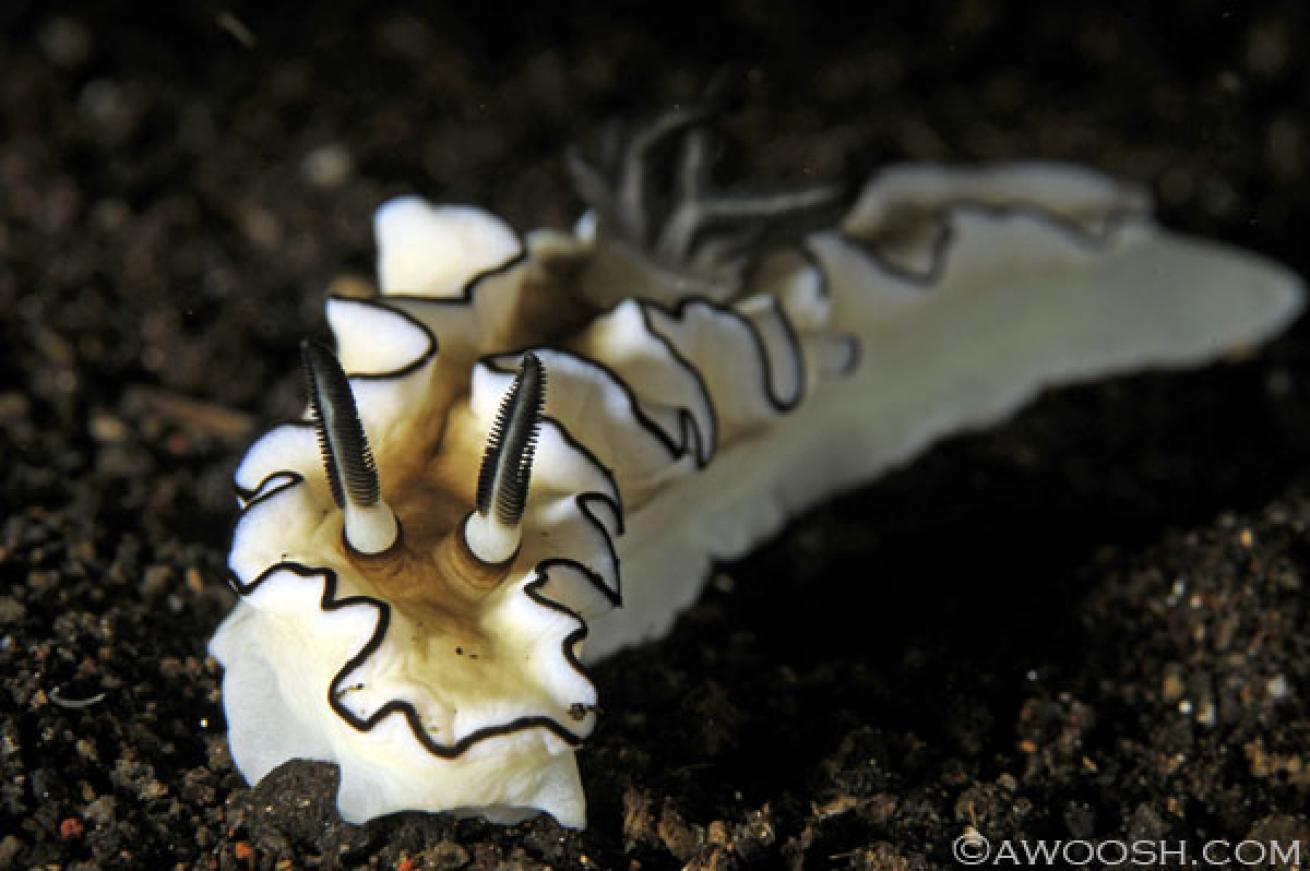
Judy GDark Margin nudibranch (Glossodoris marginata), found on a night dive on the shallow, port rail of the wreck. These nudibranchs are quite large, so easy to spot. This one was about 3 inches in length.
From Scuba Seraya Dive Resort, where I have had the pleasure to stay and dive with on several occasions, the wreck is a short boat ride away. The Liberty is also a relatively easy access shore dive from the public beach at Tulamben — just a quick swim out. As such, numerous dive operators from all over Bali bring busloads of divers for tours of the wreck daily. Several other Tulamben area dive resorts also provide a steady stream of traffic, and so it can be a busy site. Also of note is that parts of the Liberty are in such shallow water that it makes it a good destination for snorkelers. So, for the most serene, least crowded, most probable opportunities to see the larger animals that make their home on the wreck, it is recommended to plan to dive it early in the morning or late in the afternoon. The Liberty is also an awesome night dive, except when subjected to tidal currents.
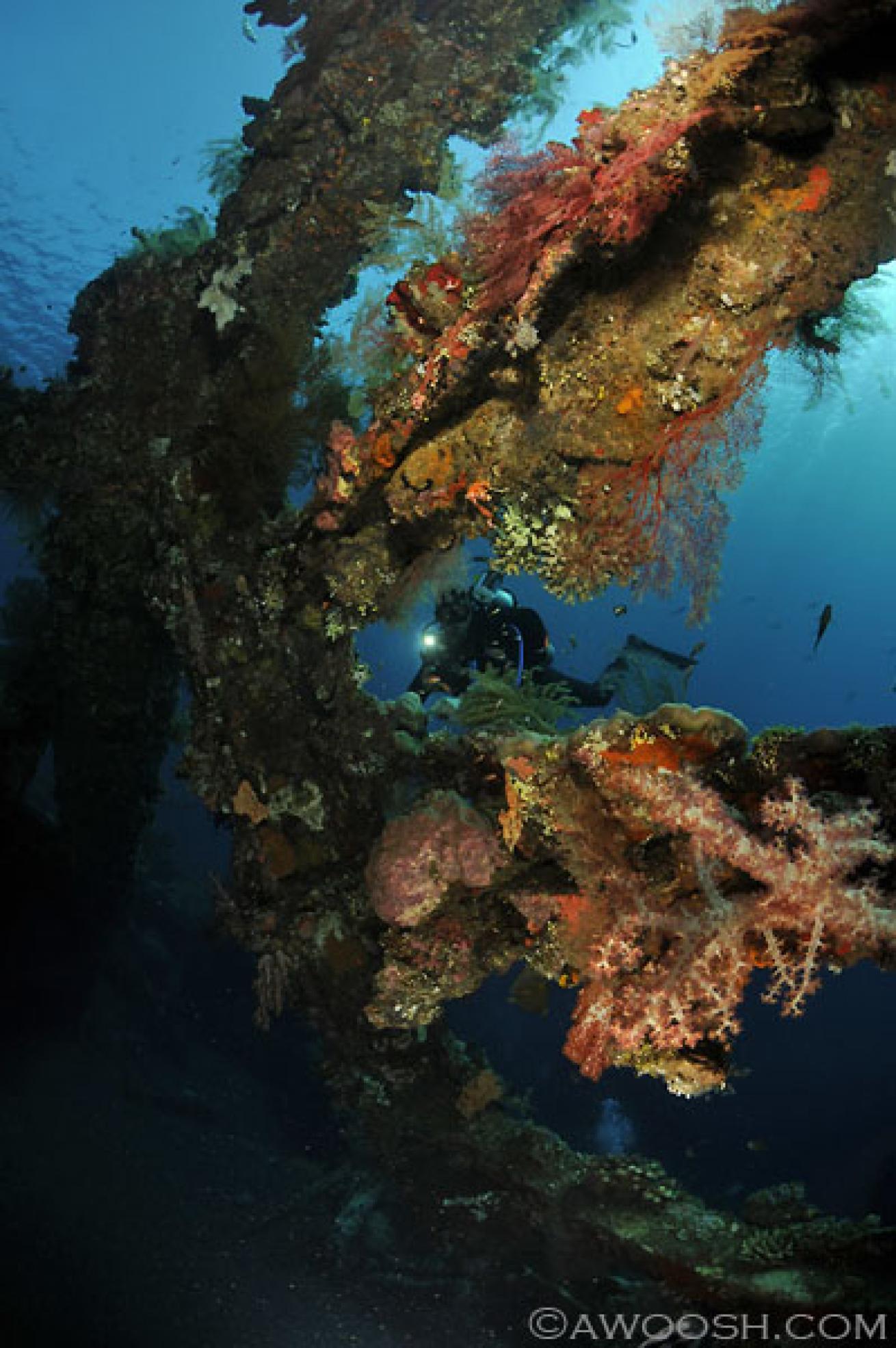
Judy GA diver exploring some of the superstructure around the mid-ships of the wreck. This image helps to illustrate how thickly encrusted the wreck has become over the years. The sponges, corals, crinoids, gorgonians etc create rich habitat for a host of creatures.
For DSLR photographers, I would recommend trying to plan to dive the Liberty a minimum of three times. For the first dive, I would suggest touring the entire ship with your camera set up for wide-angle, and bag yourself some nice, sculptural shots. You can circumnavigate the whole wreck on one dive, if you are good on gas. If you are lucky, and the visibility gods are with you, the big ball of jacks that sometimes orbits the wreck will be visible and fun to try to photograph.
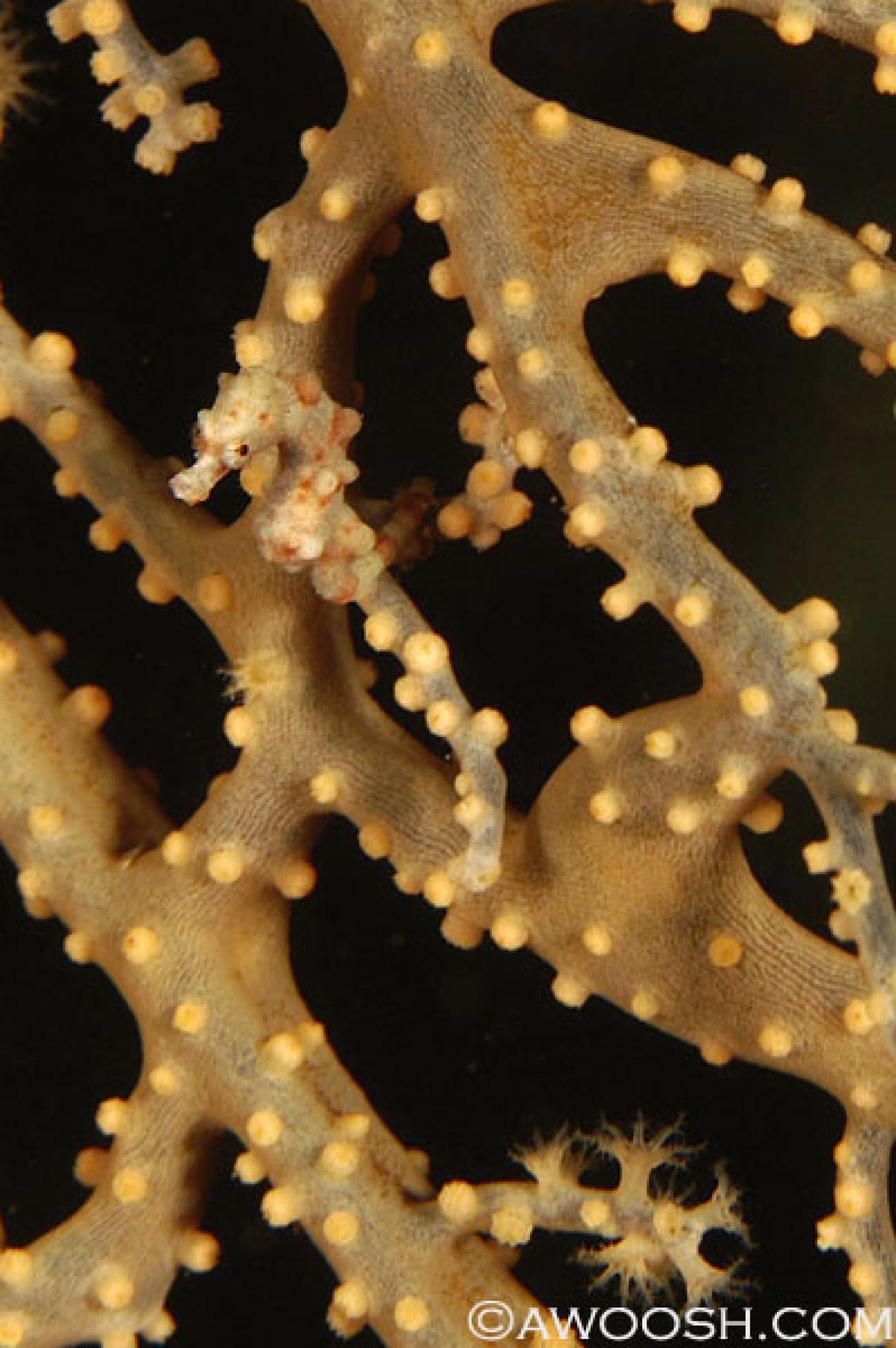
Judy GPygmy Seahorse (Hippocampus bargibanti), located on a gorgonian sea fan near the bow of the wreck. These creatures are very tiny – about the size of a grain of rice.
Then, for the second dive, I’d suggest screwing on a mid-range lens for fish portraits. You will have already scouted and found numerous fixed or non-migratory subjects to shoot on this dive, including several varieties of anemonefish — both on the wreck (look for the red tomato anemone on the tilted deck, near the bow, at about 45 feet), and spine-cheek anemonefish in the sandy shallows immediately adjacent to the wreck. Look for the big barracuda that lurks in the holds. There are massive resident groupers, and a school of bumphead parrotfish that tend to leave the wreck quite early in the morning, and return to it in the evening to wrap themselves up in their mucus "sleeping bags" for the night. There are sweetlips, filefish, triggerfish, parrotfish, lionfish, garden eels (in 25 feet of water!), sergeant majors galore, and so much more on this fantastic site.
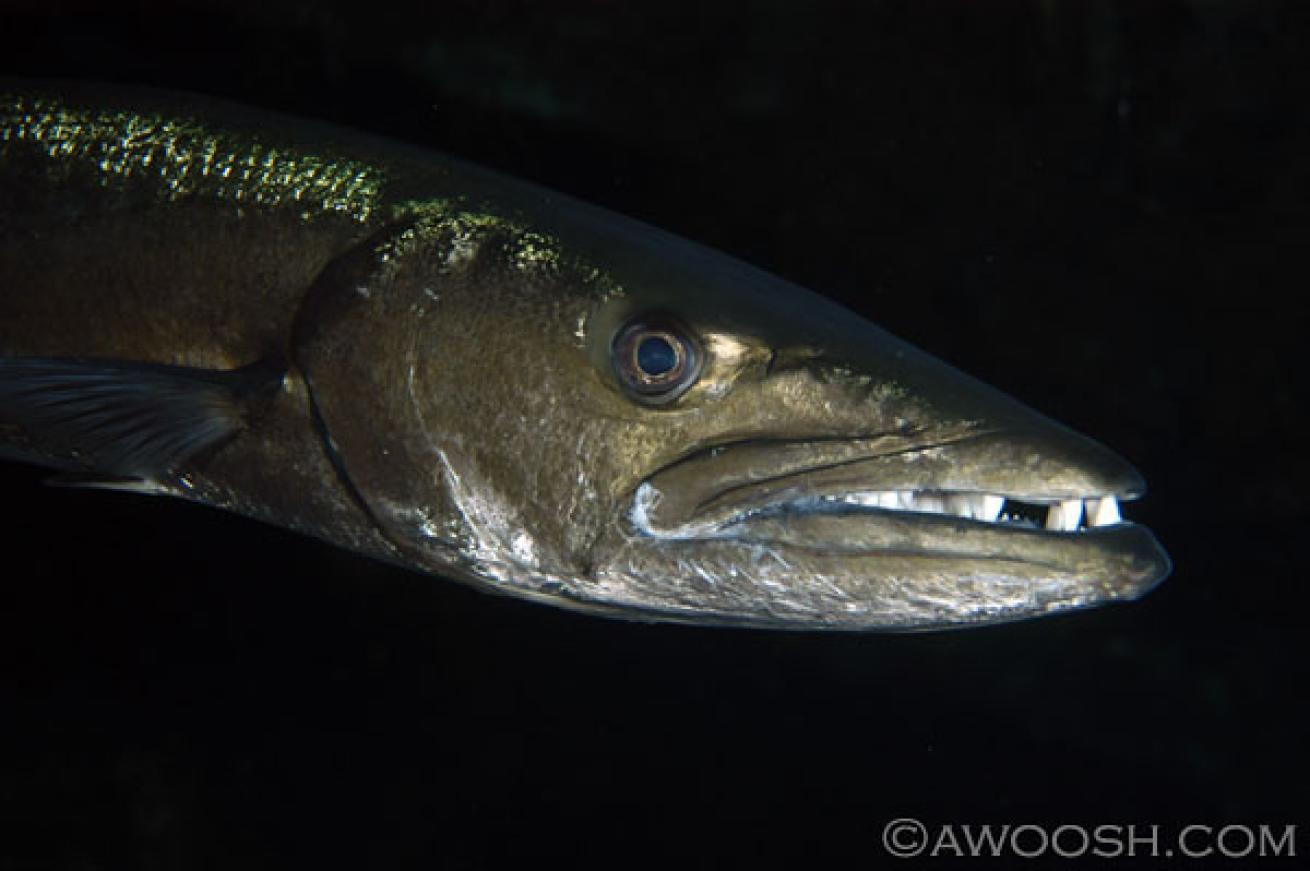
Judy GA huge barracuda lurking in one of the holds in the ship. This fish was at least five feet long and gave me quite a scare when I went into a dark hold to explore and suddenly found myself face to face with it.
For your third dive, get ready for macro. There is at least one pygmy seahorse on the Liberty. If you are fortunate enough to get to see it/them, please refrain from taking scores of pictures — the little guys are light sensitive and it clearly disturbs them to be strobed. Also, they typically make their homes on very fragile sea fans, so great care must be taken not to contact them when coming in for a close-up. A good guide will use his or her pointer to show you where the pygmy is (hopefully not touching the fan) — the ones I squinted at (and then pointed my camera and prayed) were no larger than a grain of rice. There are also a couple of leaf scorpionfish on the wreck, numerous nudibranchs, soft coral crabs, shrimp gobies in the sand, crinoid squat lobsters, ornate ghost pipefish and porcelain crabs, and so much more.
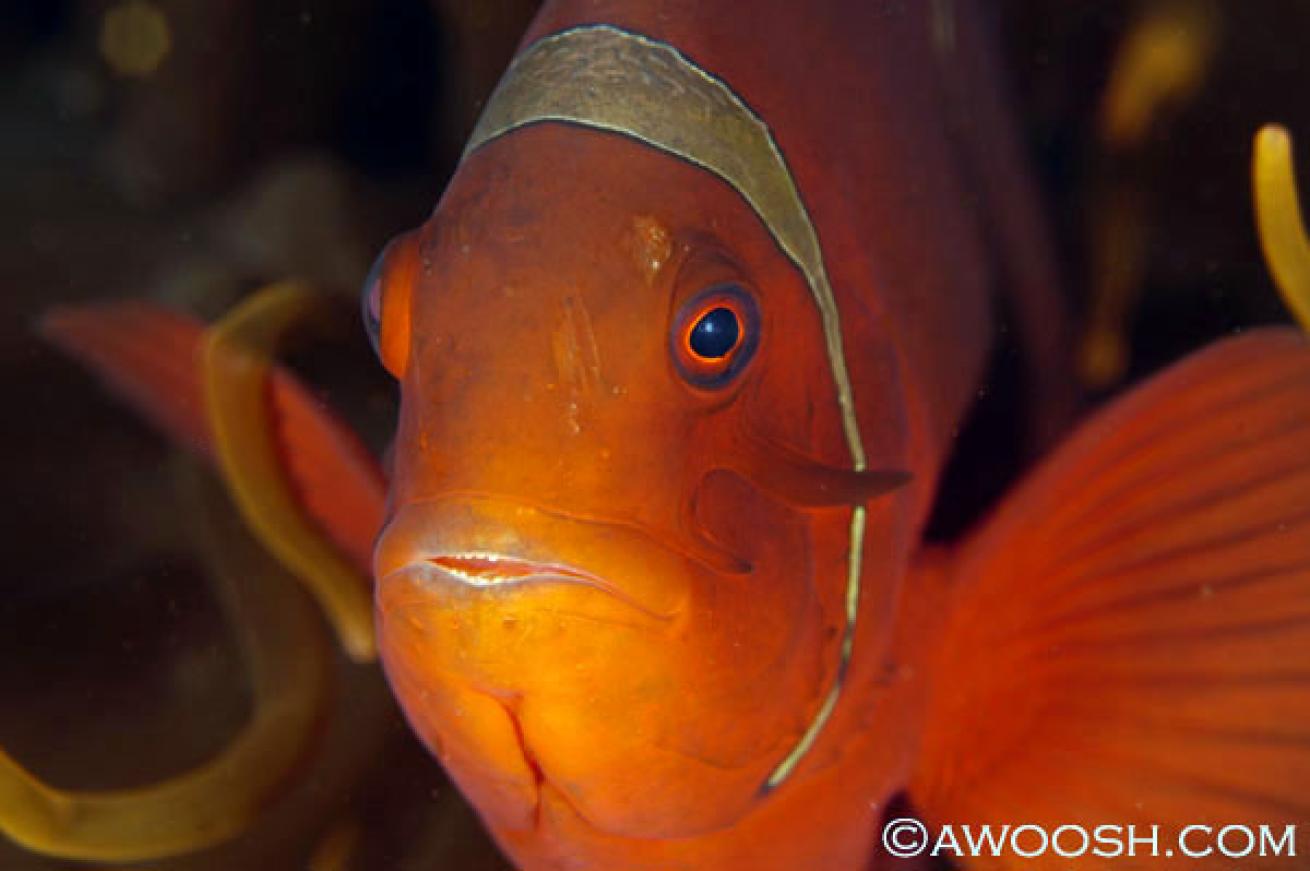
Judy GSpinecheek Anenomefish (female) on its host - a Corkscrew Tentacle Sea Anemone. The female is duskier in color than the male, and larger. This fish was about 5 inches in length.
Not to be overlooked are the coral patches on the sand around the wreck — this is where we saw ornate ghost pipefish, numerous nudibranchs, several varieties of eels, a bubble anemone with resident spine-cheek anemonefish, and there is a cool cleaning station about 30 yards from the wreck, on a small bommie, where the cleaner shrimp will clean your nails, and even your teeth, if you are so inclined. Also, not far from the wreck are several areas of sloping “muck,” which, although lacking any significant reef structure, are great for macro critter sightings. In fact, in addition to the star attraction of the Liberty wreck, there is quite a lot of fantastic muck diving in the Tulamben area, as well as pretty reefs.
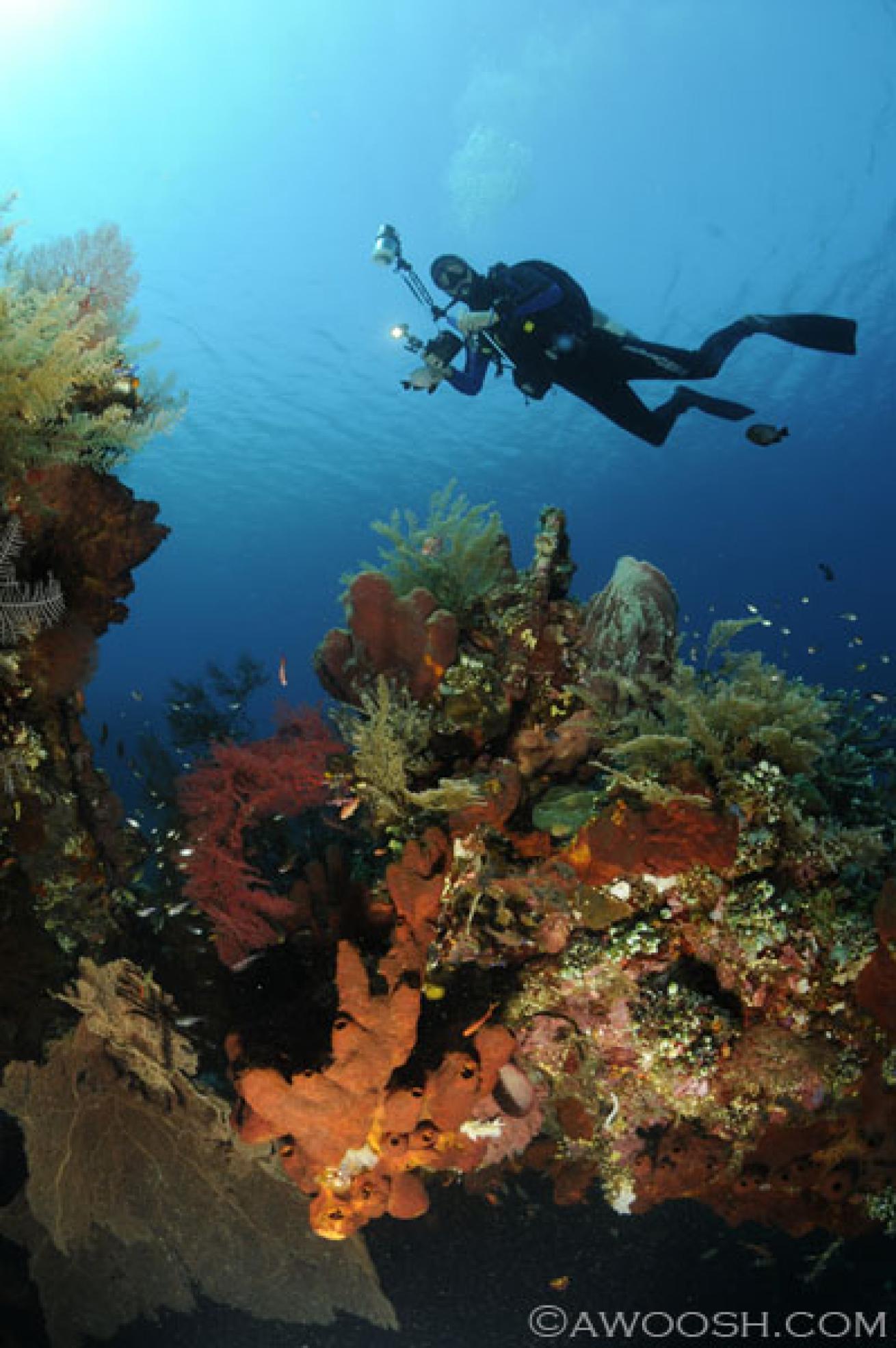
Judy GDiver above richly encrusted wreck structure, at about 70 feet.
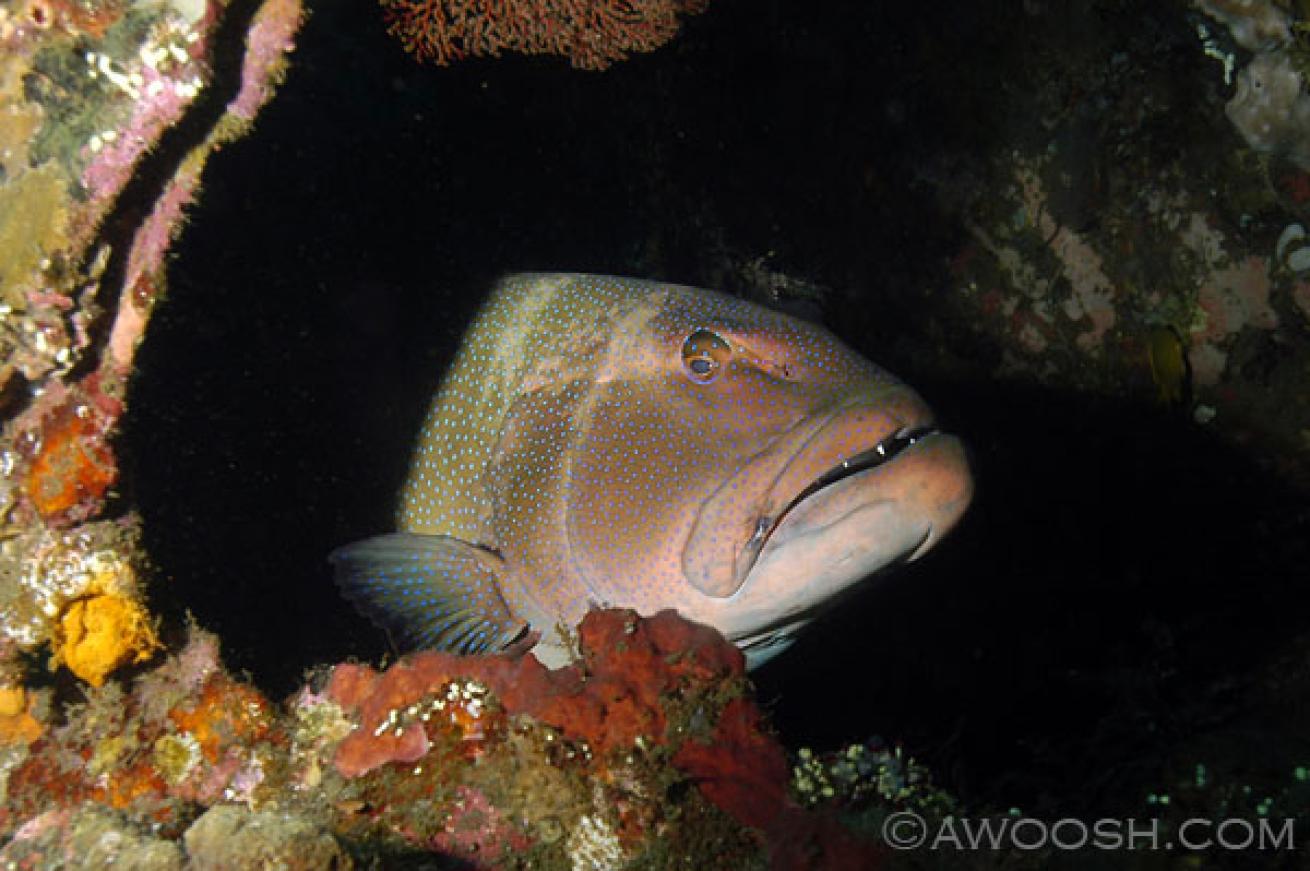
Judy GA huge Squaretail Coral Grouper (Plectropomus areolatus), making its home on the wreck.
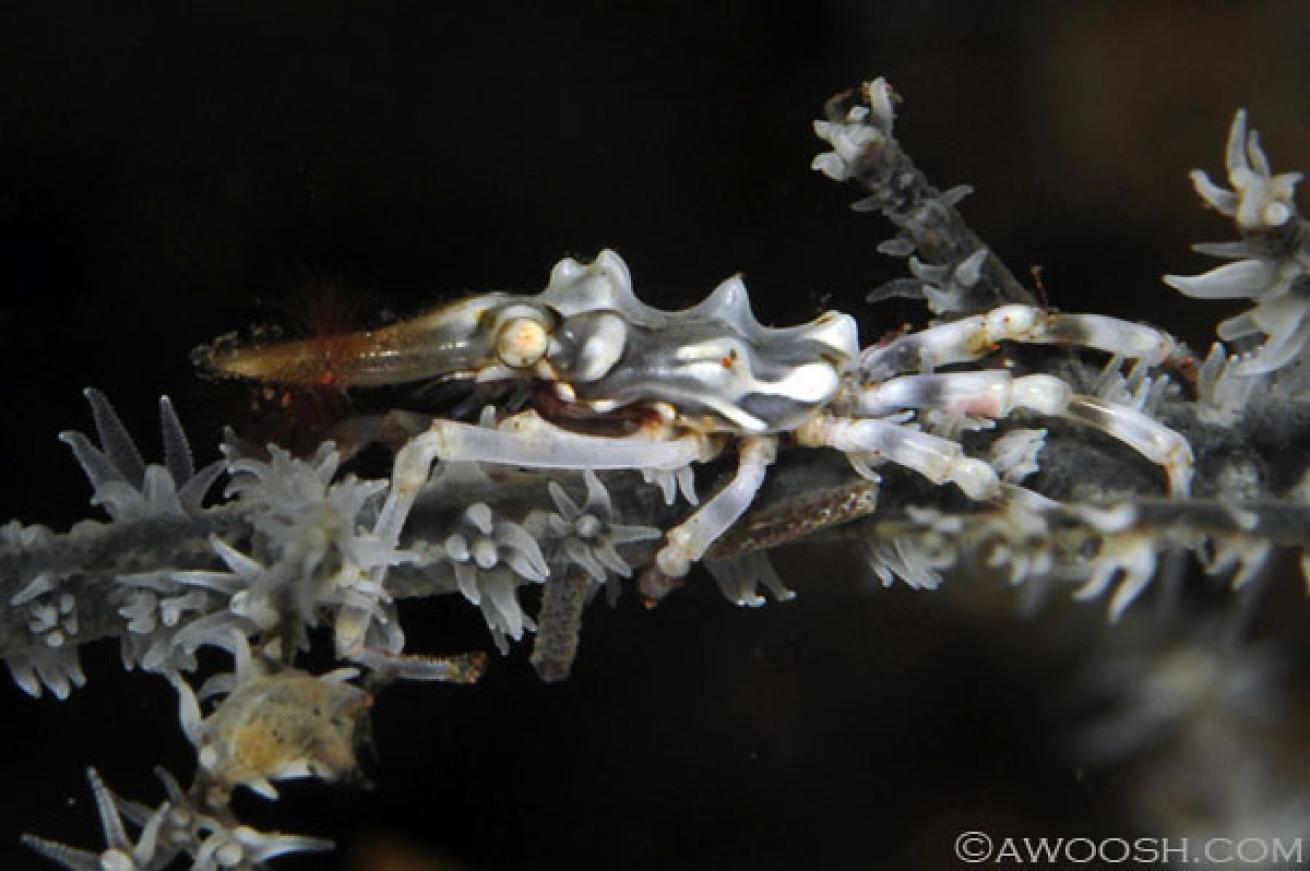
Judy GWire Coral crab (Xenocarcinus tuberculatus). These are very tiny creatures that often adopt the coloration of their wire coral habitat. This little crab was about half an inch long.
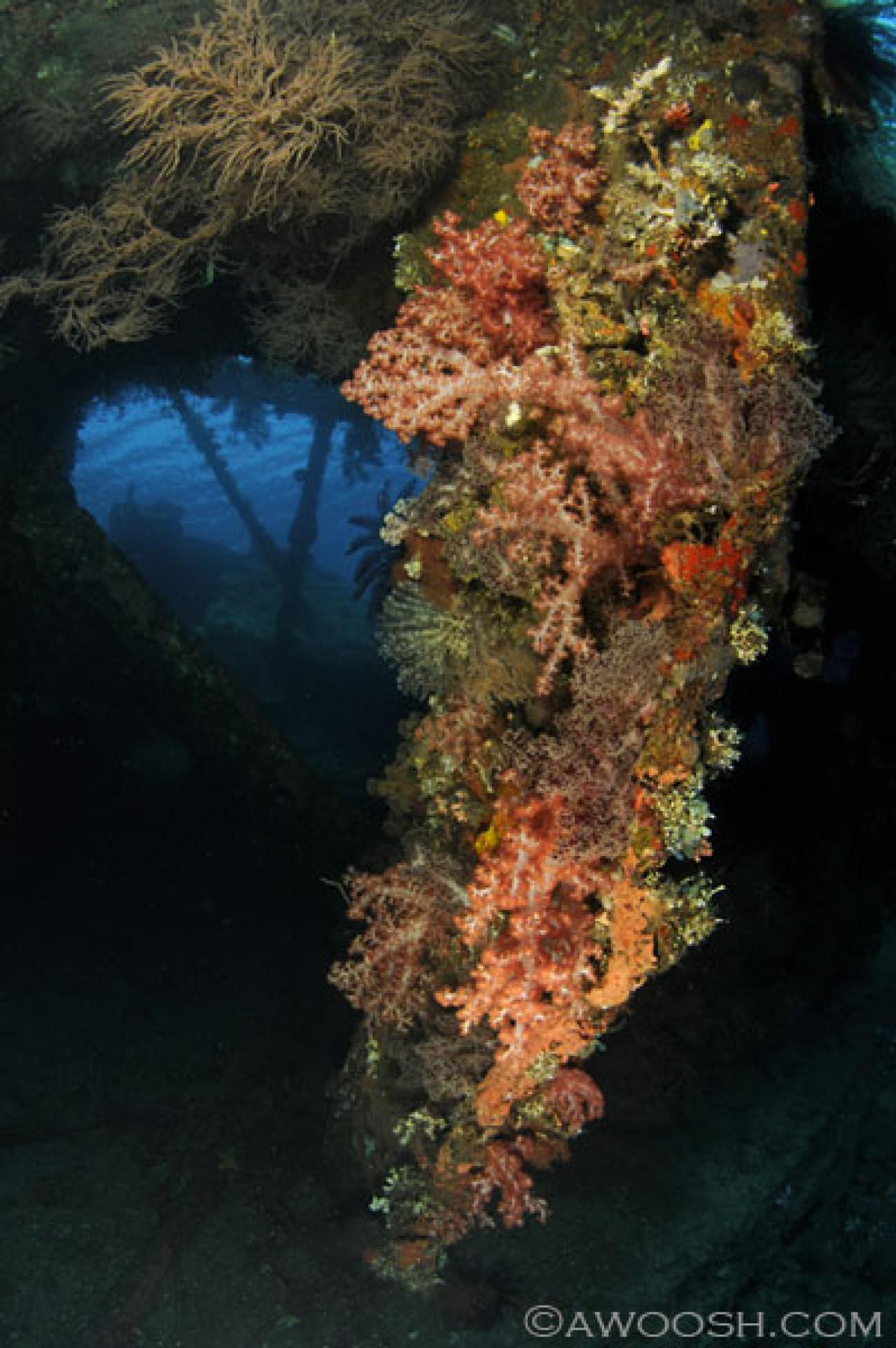
Judy GEncrusted structure of the wreck, around midships, at about 70 feet. In this area it is still, at time of writing, possible to swim “through” the wreck.
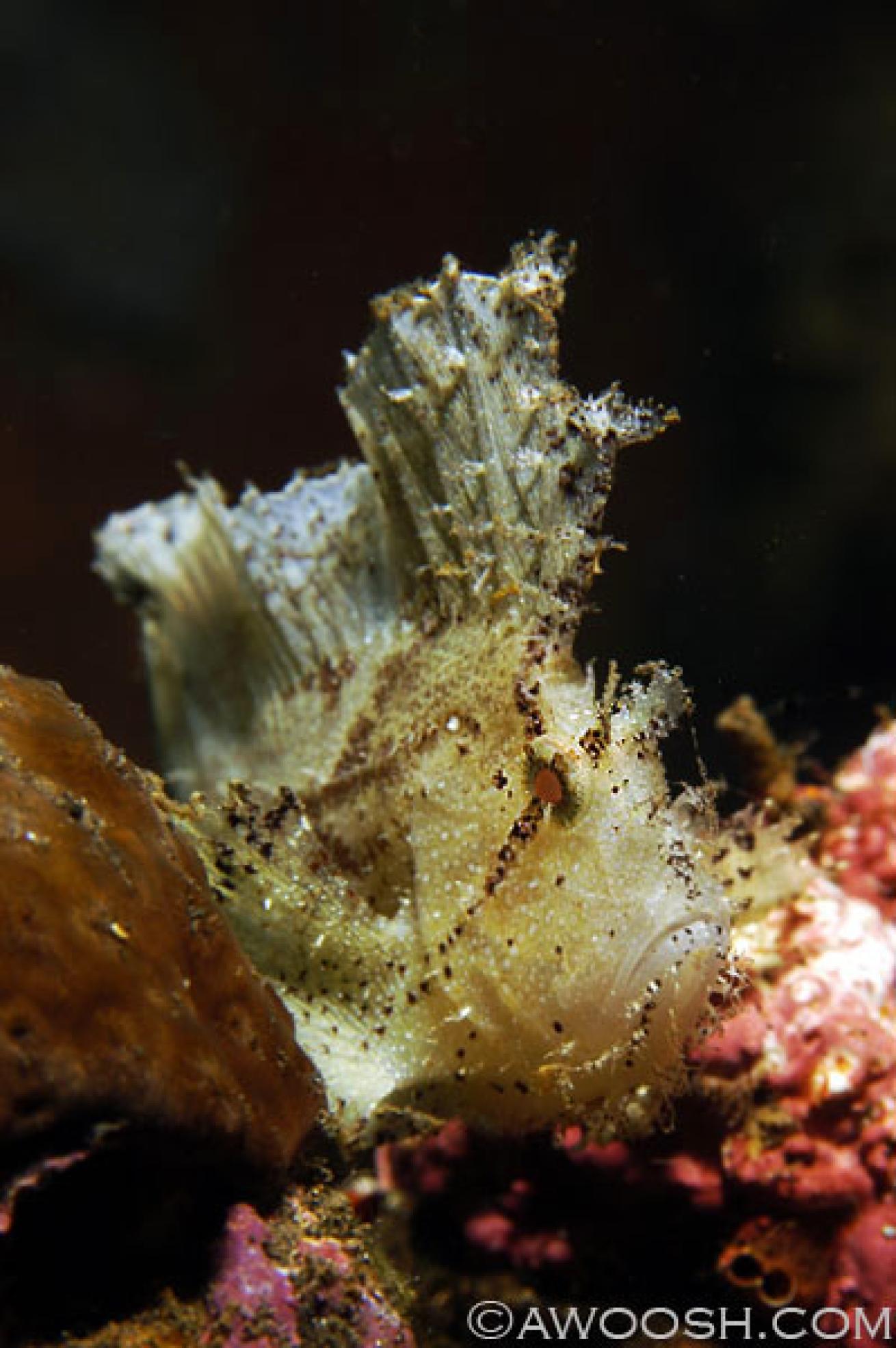
Judy GThis Leaf Scorpionfish (Taenianotus triacanthus) was found at about 60 feet of depth, near the stern of the wreck.
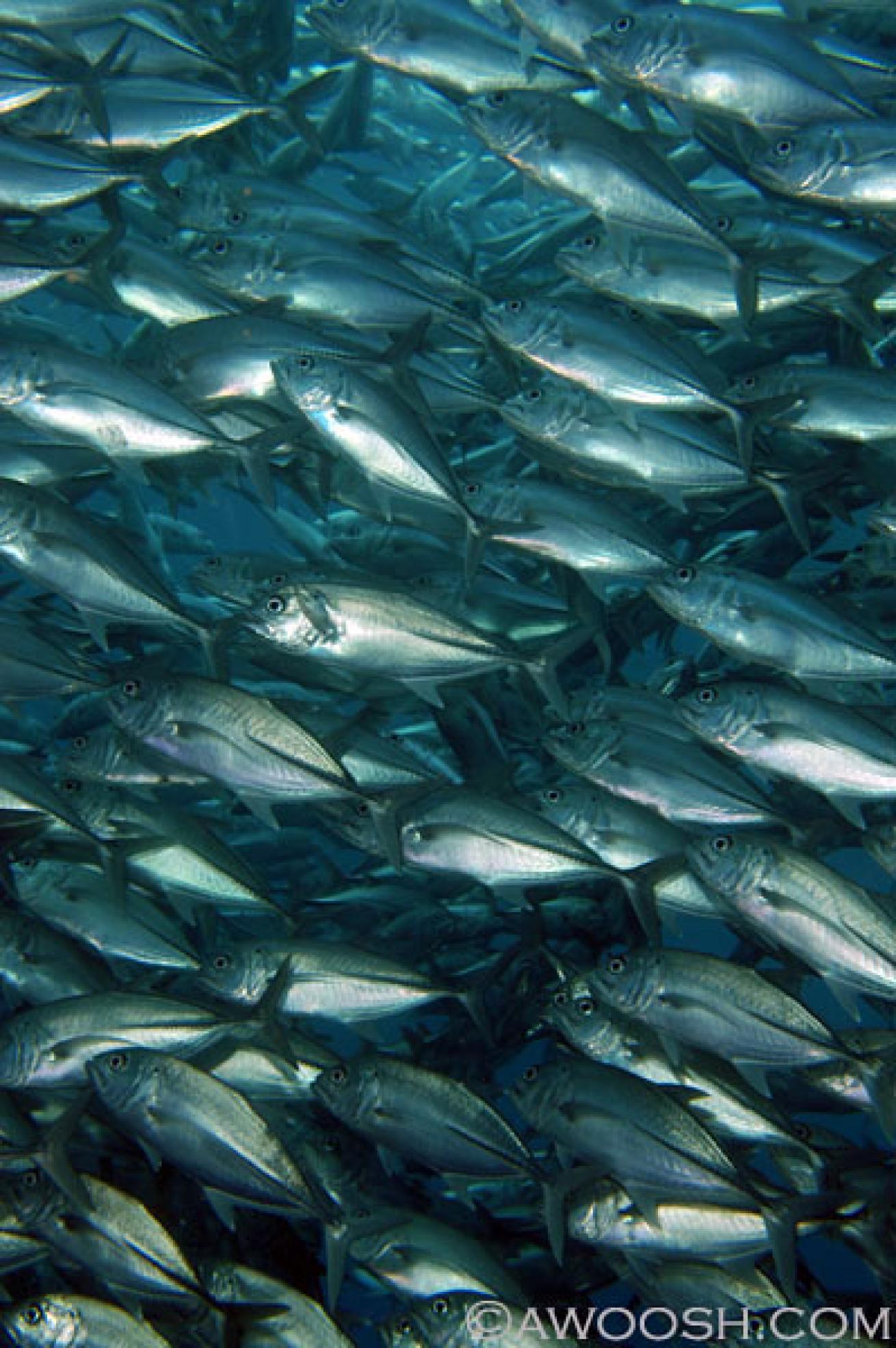
Judy GA huge swarm of jacks is often visible, orbiting the USAT Liberty wreck.
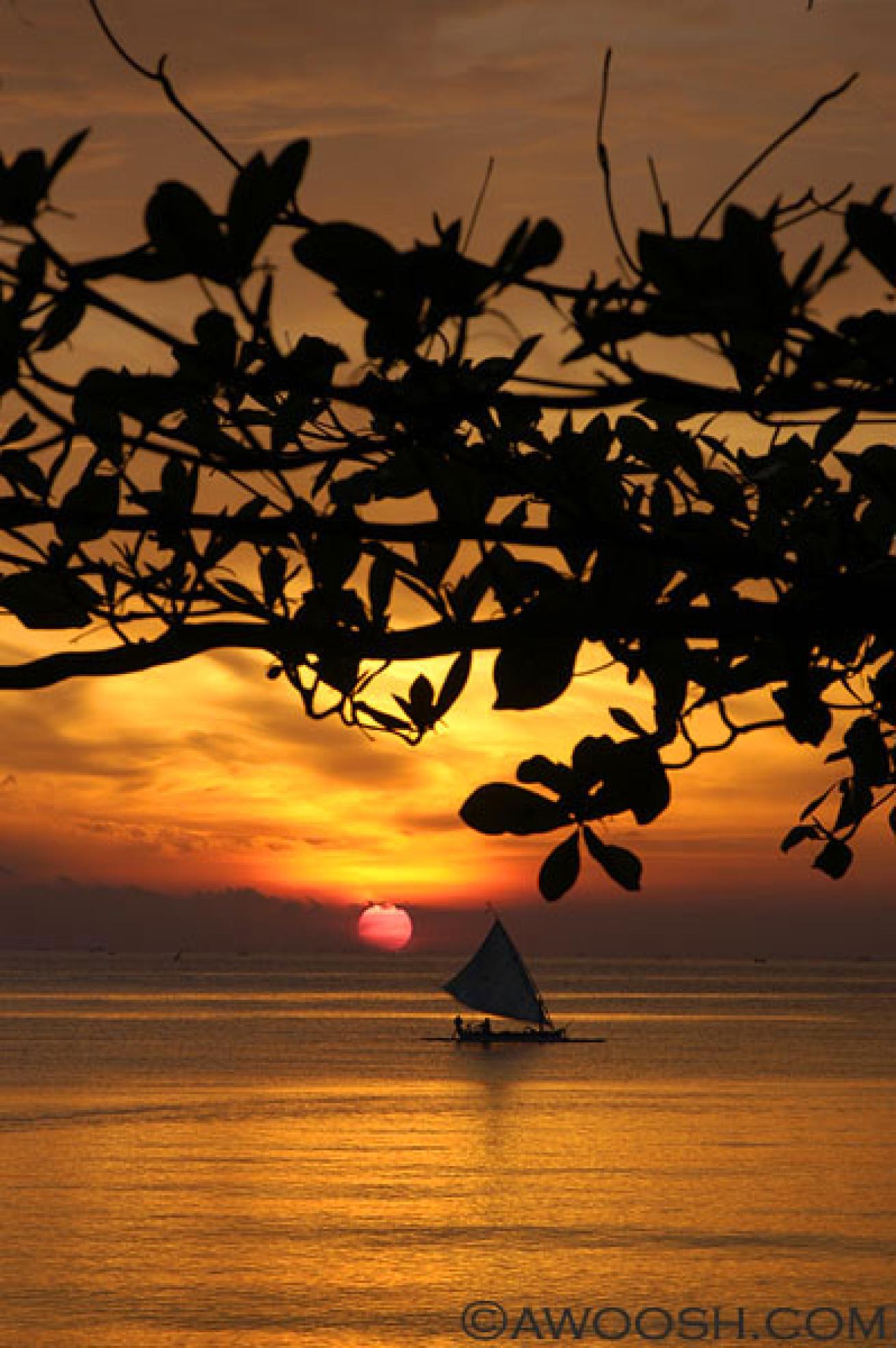
Judy GGorgeous sunrise near Tulamben, Bali. The Tulamben region of Bali is located on the northeast coast. Beautiful sunrises and fantastic early morning dives on the Liberty make getting up early worth the effort.
Finally, Bali itself is a beautiful, fascinating destination, with ample tourism infrastructure for all budgets. Beaches, resort towns, surfing, Ubud (the artists’ town), water gardens, hiking – there are many options for diversions when not diving. International nonstop flights to Bali are available through several hubs, including Jakarta, Singapore, Bangkok, Sydney, and others. Bali is also the gateway to many other prime dive areas in Indonesia – Komodo, Banda Sea, Raja Ampat, to name a few. I’ve always found it to be a great trip to plan a few days of diving in Tulamben before heading out on a live-aboard adventure in one of these areas, but diving the Tulamben area of Bali is truly worthy of a trip of its own.
Judy is an avid underwater photographer and traveler whose work has appeared in several dive publications. Judy also shares a comprehensive dive travel and photo blog.

